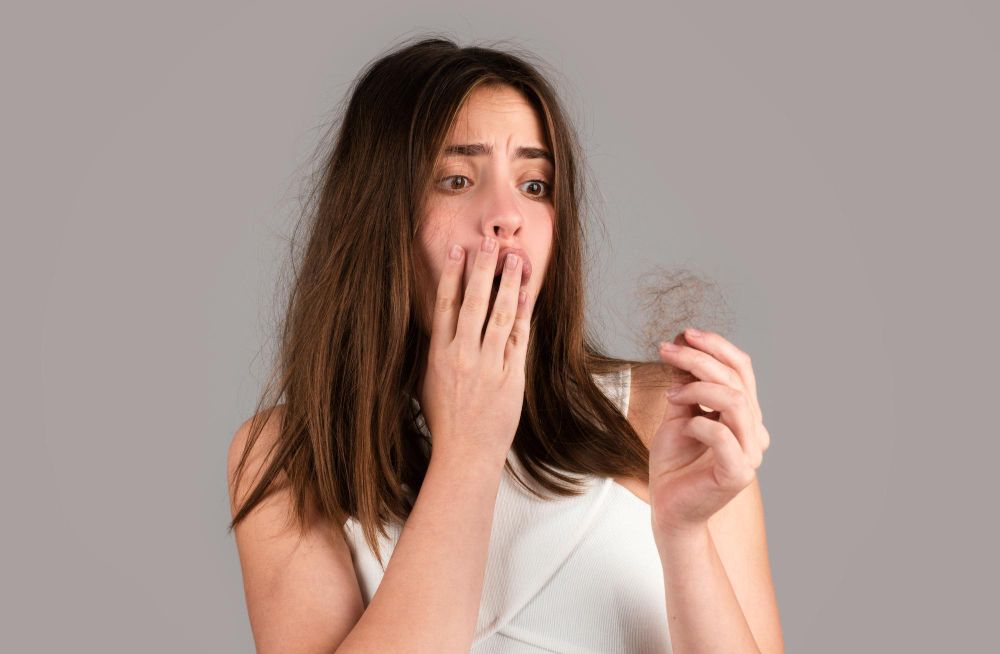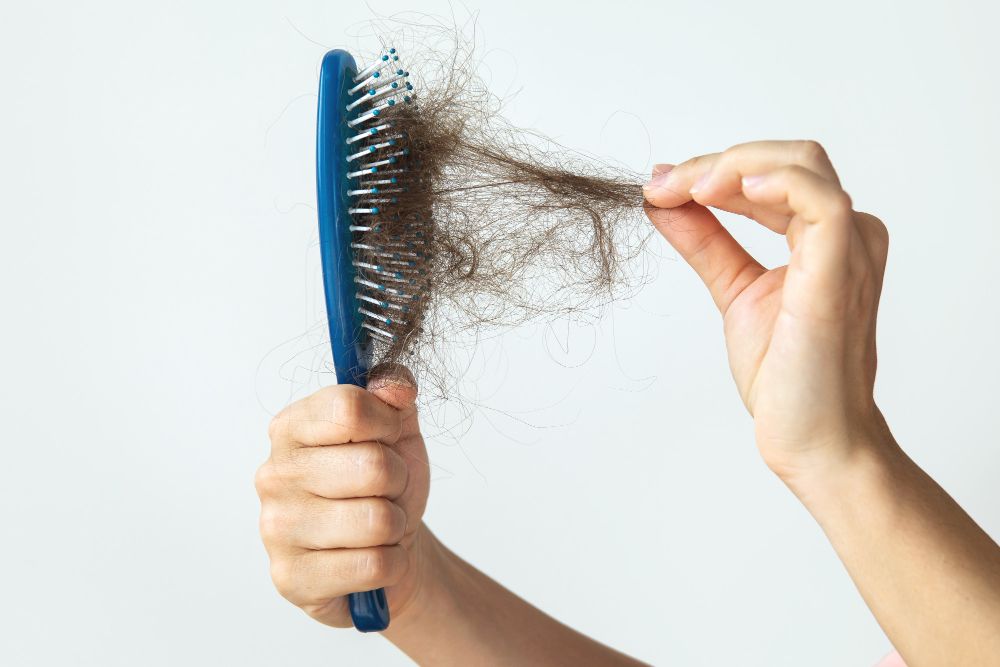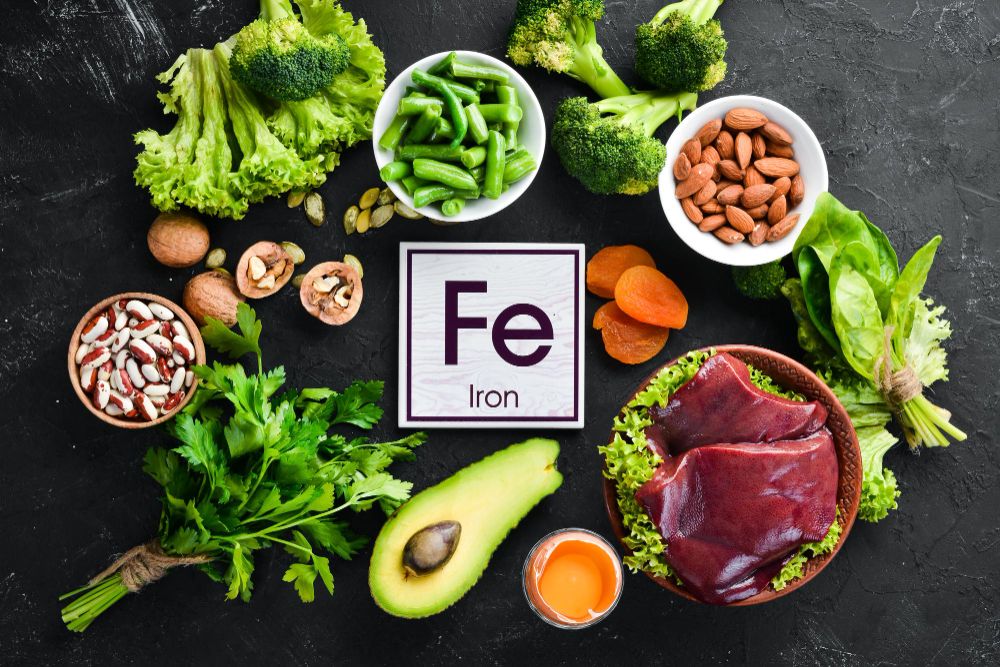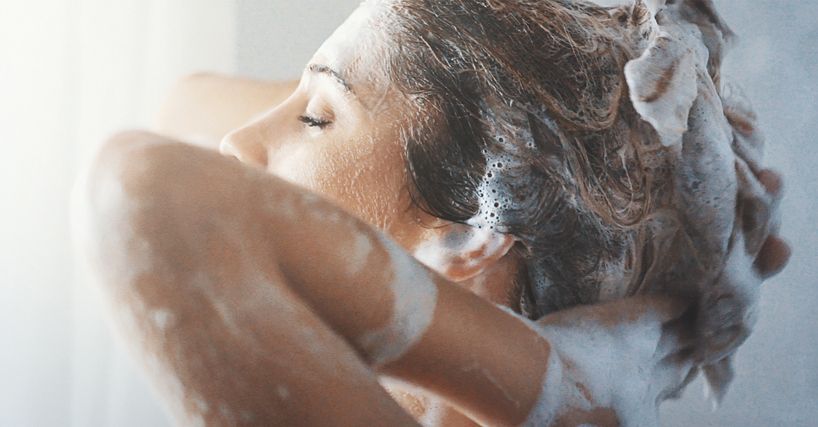
Author: Natalie Ng|Updated: 14 May 2025
If your hair’s been looking thinner lately, low iron could be the reason. Iron deficiency is one of the most common causes of hair loss, and it often goes unnoticed until you start spotting more hair on your brush or in the shower drain. Without enough iron, your body can’t produce enough red blood cells, and that affects how much oxygen gets to your hair follicles. What you eat can make a big difference. Some foods support iron absorption and help stimulate hair growth, while others might be getting in the way. Even simple changes to your diet can improve hair health—and in some cases, stop further shedding. If you’re dealing with hair loss related to low iron, you're not stuck. Keep reading for 10 easy ways to support hair regrowth through smart, simple nutrition.

Importance of Iron Intake for Hair Growth

Iron helps carry oxygen to hair follicles
Iron plays a direct role in hair growth. It supports the production of hemoglobin, the part of red blood cells that carries oxygen. Your scalp and hair follicles rely on this oxygen supply to grow healthy strands. Without enough iron, this process slows down, and you may start to see signs like thinning hair, slower regrowth, or increased shedding.
Iron deficiency reduces ferritin levels
Ferritin is a protein that stores iron in the body. Low ferritin is one of the first signs of iron deficiency, even before anemia develops. When ferritin drops, there’s less iron available for non-essential functions like hair production. This is often linked to telogen effluvium, a type of hair loss caused by shifts in the growth cycle.
Common symptoms to watch for
Low iron doesn’t just affect your hair. Other signs include brittle nails, feeling tired, pale skin, and lightheadedness. If you notice these along with hair loss, a blood test can help confirm if low iron or iron deficiency anaemia is the cause.
If your hair loss is linked to iron deficiency, the right foods can make a difference. By focusing on what you eat, you can support your iron levels and help your hair grow back stronger. Here are 10 nutritional fixes that can support hair regrowth and improve overall hair health.

Signs Iron Deficiency Is Affecting Your Hair

Hair changes are often one of the first visible signs of low iron
Iron deficiency doesn’t always show up in obvious ways at first, but changes in your hair can be an early clue. Since hair growth isn’t a priority function in the body, it’s one of the first areas affected when iron levels drop. Paying attention to these changes can help you take action before the issue becomes more serious.
Signs your hair may reflect low iron levels
• More hair than usual falling out in the shower or on your brush
• Thinning along the hairline or parting becoming wider
• Slower hair growth or weak, brittle strands
• Visible scalp in areas that were once fuller
• Dry texture or dull appearance even with regular care
These signs don’t always mean iron deficiency on their own, but if they appear alongside fatigue, pale skin, or brittle nails, it could be worth checking your iron levels with a blood test. Early detection allows you to correct low iron through diet, iron supplements, or other changes before hair loss becomes more severe.
Read More
Book Now to Experience
F8 Hair Regrowth Treatment
1 Minute Self-Registration
Date should not be before minimal date

10 Nutritional Fixes That Support Hair Growth and Iron Levels

1. Best Food Sources to Boost Iron and Prevent Hair Loss
Include both heme and non-heme iron in your diet
Your body needs iron to produce red blood cells, which carry oxygen to the scalp and hair follicles. Without enough iron, hair growth slows and shedding increases. Eating iron rich foods every day can help restore your levels and reduce hair loss linked to iron deficiency.
Animal-based foods for better absorption
Red meat, turkey, chicken, and fish are top sources of heme iron—the type your body absorbs easily. Oysters, clams, and mussels are also packed with iron, and they bring along zinc and other nutrients that support hair health. These options are especially helpful if you're iron deficient or experiencing hair loss iron deficiency triggers.
Plant-based foods that support iron intake
Lentils, spinach, tofu, quinoa, pumpkin seeds, and fortified cereals offer non-heme iron. While this form isn’t absorbed as efficiently, pairing it with foods high in vitamin C—like citrus fruits, bell peppers, or tomatoes—can help your body absorb iron better.
Foods and drinks that block absorption
If you're trying to raise your iron levels, skip coffee, tea, and calcium-rich foods during iron-rich meals. These can interfere with your body’s ability to absorb iron and may slow your progress, especially if you're already low on iron.
2. Food Combinations That Improve Iron Absorption
Pair iron-rich foods with vitamin C
Iron from plant foods isn't absorbed as easily as iron from animal sources. But you can help your body absorb it better by eating it alongside vitamin C-rich ingredients. This pairing makes non-heme iron easier for your body to take in, which is important if you’re trying to improve hair health and reduce hair loss caused by iron deficiency.
Easy combinations that work
• Add orange slices or strawberries to a spinach salad
• Squeeze lemon juice over lentils or quinoa bowls
• Serve lean beef with steamed broccoli or Brussels sprouts
• Mix tomatoes into whole grains like bulgur or brown rice
These simple combinations support iron absorption and help your body produce enough red blood cells to carry oxygen to your hair follicles.
Avoid blocking iron with the wrong foods
Certain foods and drinks can interfere with your body’s ability to absorb iron. Coffee, tea, and dairy products reduce how much iron your body takes in—especially when consumed at the same time as iron-rich meals.
Tips for better timing
• Wait at least an hour after eating iron-rich meals before drinking tea or coffee
• Keep calcium-rich foods or supplements for other times of the day
• Avoid combining whole grains high in phytic acid with iron sources unless paired with vitamin C
Planning these food combinations and timing them right helps prevent iron deficiency and supports healthy hair growth.
3. Vitamin C-Rich Foods That Help Your Body Absorb Iron
Add more vitamin C to boost iron uptake
Vitamin C makes a big difference when it comes to absorbing iron, especially from plant-based foods. It helps convert iron into a form your body can absorb more easily. If you’re low in iron or dealing with hair loss linked to iron deficiency, adding enough vitamin C to your meals is a simple step that can support better absorption and improve hair growth over time.
Best vitamin C foods to include with iron meals
You’ll get the most benefit when you eat vitamin C at the same time as iron-rich foods. Some of the most effective options include:
• Citrus fruits like oranges, lemons, and grapefruits
• Bell peppers—especially red and yellow ones
• Strawberries, kiwis, and pineapples
• Tomatoes, Brussels sprouts, and broccoli
These foods can boost how much iron your body absorbs by up to three times. Try adding strawberries to your breakfast oats, bell peppers to your lunch salad, or tomatoes and lemon juice to your grain bowls.
Why timing makes a difference
For vitamin C to work, it needs to be present during digestion. That means eating it in the same meal as your iron source—not hours later. This simple pairing helps your body use more iron and lowers the risk of deficiency-related hair loss.
4. Plant-Based Pairings That Improve Iron Absorption
Combine plant iron with foods that boost uptake
If you follow a plant-based diet, you’re mostly getting non-heme iron, which your body doesn’t absorb as easily. To support better iron absorption and avoid hair loss linked to low iron, it helps to combine certain plant foods with nutrients that make iron easier to take in.
Best plant-based combinations for hair health
• Add bell peppers or orange slices to spinach or kale salads
• Pair lentils or chickpeas with tomatoes, lemon juice, or kiwi
• Cook quinoa or brown rice with garlic and onions to help with iron uptake
• Use strawberries or citrus segments in grain bowls or alongside legumes
These combinations increase iron absorption and give your body the tools it needs to produce red blood cells and stimulate hair growth.
Foods that block iron from plants
Tannins in coffee and tea, calcium-rich foods, and whole grains with high phytic acid can all reduce iron absorption from plant sources. If you’re relying on plant-based iron, avoid these foods during meals that are rich in iron.
Simple adjustments to improve iron intake
• Wait at least an hour after eating before having coffee or tea
• Eat calcium-rich foods at different times of the day
• Combine plant iron sources with vitamin C every time
These small shifts can help your body absorb more iron and support stronger, healthier hair.
5. Essential B-Vitamins That Support Iron and Hair Growth
B-vitamins help your body use iron effectively
Iron alone isn’t always enough. Your body also needs certain B-vitamins to support red blood cell production and keep your hair follicles healthy. Without these vitamins, even if you're eating enough iron, you might still face issues like thinning hair or brittle strands.
Key B-vitamins for hair health and iron metabolism
• Vitamin B12 helps produce red blood cells and supports the hair growth cycle. It also plays a role in how your body uses iron.
• Folate (Vitamin B9) works with B12 to form red blood cells and helps with cell division at the hair follicles.
• Vitamin B6 supports protein metabolism and helps move iron through your system.
Where to get these nutrients
You’ll find these B-vitamins in foods like eggs, whole grains, leafy greens, legumes, and fish. If you’re low in any of them, taking supplements under medical guidance can help fill the gap. A blood test can check for deficiencies, especially if you're dealing with symptoms like fatigue, hair loss, or pale skin.
Getting enough B-vitamins is just as important as your iron intake when it comes to maintaining strong hair and preventing deficiency-related hair loss.
6. Get Enough Protein and Choose the Right Type for Iron Absorption
Protein supports hair growth and helps your body use iron
Protein is essential for building and maintaining strong hair. It also plays a role in how your body absorbs and uses iron. If you're low in protein, your body may struggle to make red blood cells and deliver oxygen to your hair follicles—two things that are key for preventing hair loss caused by iron deficiency.
Combine protein with iron for better results
Eating enough protein supports the production of keratin (the main protein in hair) and helps your body absorb iron more efficiently. Certain amino acids found in protein-rich foods can improve iron uptake, especially when paired with iron-rich meals.
Best protein sources for hair and iron support
• Animal-based proteins like red meat, poultry, fish, and eggs give you both heme iron and complete proteins. These are ideal for increasing iron levels quickly and supporting hair regrowth.
• Plant-based proteins such as lentils, tofu, quinoa, and beans provide non-heme iron, but they need to be paired with vitamin C-rich foods (like tomatoes or citrus fruits) to improve absorption.
Mix protein types for a balanced approach
Including both animal and plant proteins in your meals helps you cover more nutritional ground. While heme iron from meat is absorbed more easily, plant foods bring fiber, antioxidants, and lower saturated fat. When combined wisely, both sources can support better iron intake and healthier hair.
7. Avoid Foods That Block Iron Absorption
Some foods can reduce how much iron your body takes in
Even if you’re eating enough iron, certain foods and drinks can stop your body from absorbing it properly. This can slow down red blood cell production and affect how much oxygen reaches your hair follicles—leading to hair loss over time.
Foods and drinks that interfere with iron absorption
• Coffee and tea contain tannins, which can lower iron absorption if consumed with or soon after meals
• Calcium-rich foods and supplements compete with iron in the digestive system
• Whole grains and legumes contain phytic acid, which can bind to iron and make it harder for your body to use
• Red wine, cocoa, and some berries contain polyphenols that may also reduce absorption when consumed in large amounts with iron-rich foods
Simple adjustments to protect your iron levels
• Drink coffee or tea at least one hour before or after your iron-rich meals
• Keep calcium-rich foods separate from meals high in iron
• If eating whole grains or legumes, pair them with vitamin C-rich foods to offset the impact of phytic acid
• Limit red wine or cocoa when trying to improve iron levels
These small changes can improve iron absorption and support healthier hair over time, especially if you're managing iron deficiency or hair loss related to low iron levels.
8. Plan Meals That Improve Iron Absorption Throughout the Day
Timing and food pairings make a difference
It’s not just what you eat—it’s when and how you eat it. Spacing out certain foods and planning smart combinations can improve your body’s ability to absorb iron. This helps maintain healthy red blood cell levels and supports hair follicles, which need a steady oxygen supply for proper hair growth.
Sample strategies for better daily iron intake
• Have iron-fortified cereal with citrus fruit or a glass of orange juice at breakfast
• Pair lean red meat or chicken with broccoli, bell peppers, or Brussels sprouts at lunch or dinner
• Combine legumes or quinoa with tomatoes or leafy greens to boost non-heme iron absorption
Avoid nutrient competition during meals
Calcium, caffeine, and certain plant compounds can interfere with iron absorption. Space these foods out from your iron-rich meals by at least two hours.
• Take calcium supplements at a different time of day
• Drink tea or coffee between meals, not during
• Balance whole grains with vitamin C-rich ingredients to improve absorption
This kind of meal planning supports consistent iron levels, helping prevent iron deficiency and reduce the risk of hair loss.
9. Simple Recipes That Increase Iron Intake for Hair Recovery
Meal choices support iron levels and reduce hair thinning
What you cook at home plays a key role in improving iron intake. Meals made with iron rich foods, vitamin C, and balanced ingredients help your body absorb more iron and support stronger hair growth—especially if you’re dealing with hair loss caused by iron deficiency.
Iron-friendly recipe ideas
• Make a breakfast bowl with oats, spinach, pumpkin seeds, and strawberries
• Blend a smoothie with kale, frozen berries, orange juice, and a spoon of pumpkin seeds
• Cook lentils with garlic, bell peppers, and crushed tomatoes
• Build a grain bowl with brown rice, chickpeas, lemon juice, and roasted broccoli
These meals combine plant-based iron, vitamin C, and protein, which support red blood cell production and oxygen flow to the scalp. Eating nutrient-dense recipes like these helps restore low iron levels and supports hair regrowth in a natural, sustainable way.
10. Daily Habits That Improve Iron Absorption and Hair Health
Everyday choices affect how your body uses iron
Your routine has a direct impact on how much iron your body absorbs and how well it supports hair growth. Timing your meals, avoiding certain food combinations, and supporting your digestion can all make a difference—especially if you’re managing hair loss caused by iron deficiency.
Easy adjustments that support better iron use
• Don’t drink coffee or tea with iron-rich meals—wait at least one hour
• Pair iron-rich foods with vitamin C ingredients to improve absorption
• Separate calcium supplements and dairy from meals that contain iron
• Keep meals consistent throughout the day to help with nutrient absorption
• Avoid exercising right after meals to allow proper digestion and iron uptake
These habit changes help your body make better use of iron from your diet, support red blood cell production, and deliver oxygen to hair follicles—making it easier to maintain healthy hair growth.

F8 Hair Regrowth Treatment to Support Iron-Related Hair Loss
A non-invasive treatment that works with your hair recovery plan
If you're dealing with hair loss caused by iron deficiency, addressing your iron levels through diet and supplements is essential—but combining this with targeted scalp care can help improve results faster. The F8 Hair Regrowth Treatment supports healthy hair growth by improving scalp circulation and strengthening hair follicles, especially when hair thinning is already visible.
How F8 Hair Regrowth Treatment works
The treatment uses low-energy laser technology to stimulate the hair papilla and surrounding capillaries. This boosts blood flow and helps deliver more oxygen and nutrients to the hair follicles—key benefits for anyone dealing with low iron levels or iron deficiency anemia. The laser is gentle and non-invasive, making it suitable for both men and women.
After laser exposure, a professional applies a hair growth serum directly onto the scalp. This serum helps cleanse the scalp, reduce excess sebum, and hydrate the skin, creating a balanced environment that supports new hair growth. When iron levels are improving through diet or iron supplementation, treatments like F8 help deliver those nutrients where they’re needed most.
Why it helps in iron deficiency-related hair loss
Hair loss linked to iron deficiency often involves weakened follicles and poor scalp circulation due to a lack of oxygen. The F8 treatment targets these exact concerns. By improving microcirculation and enhancing the scalp’s ability to absorb nutrients, it works alongside your efforts to increase iron intake and support red blood cell production. This dual approach strengthens the hair growth cycle from both the inside and outside.
Advantages of the F8 Hair Regrowth Treatment
• Non-invasive and painless
• Strengthens hair follicles and stimulates hair regrowth
• Supports better nutrient delivery to the scalp
• Helps calm sebum production and unclog blocked follicles
• Safe for both women and men experiencing hair thinning
• No downtime or recovery needed
If you're already making changes to your diet to fight hair loss iron deficiency causes, pairing that with scalp-focused care like F8 can speed up visible improvements in hair volume and strength.
Book F8 now and take the next step toward stronger, fuller hair.
New Beauty's F8 Hair Regrowth TreatmentBook Now to Experience
F8 Hair Regrowth Treatment
1 Minute Self-Registration
Date should not be before minimal date
FAQ
Can iron deficiency cause permanent hair loss?
Iron deficiency is a common cause of temporary hair loss, especially in the form of telogen effluvium, where hair sheds more than usual. If caught early and treated with proper iron intake—through iron rich foods, supplements, or changes to your diet—hair can regrow. However, if iron levels remain low for an extended period and follicles stay inactive, long-term thinning may occur. A blood test can help detect low iron levels early, preventing long-term damage to hair follicles.
How long does it take to see hair regrowth after improving iron levels?
Most people begin to see changes in hair volume and strength around 3 to 6 months after improving their iron levels. This can vary depending on how low your iron was to begin with, whether you're taking iron supplements, and if you're addressing other risk factors like stress or nutritional deficiencies. For the best results, aim for a well balanced diet and pair it with treatments that support scalp circulation and follicle health.
Can taking too much iron cause hair loss?
Yes, too much iron in the body—especially from high-dose iron supplements taken without medical supervision—can lead to health issues, including oxidative stress, which may indirectly affect hair follicles. Iron overload can also interfere with your body’s ability to absorb other essential nutrients linked to hair growth. Always follow a doctor’s advice when taking iron supplementation, and avoid self-diagnosing iron deficiency.
Is hair thinning from iron deficiency different from genetic hair loss?
Yes, iron deficiency hair loss and genetic hair loss (like male or female pattern baldness) have different causes and patterns. Iron deficiency causes diffuse thinning across the scalp and is usually reversible with proper iron intake and nutritional support. Genetic hair loss is often gradual, occurs in specific areas, and may require long-term treatment like topical solutions or procedures. Identifying the underlying cause is important before starting any hair loss treatment.
Are there specific vitamins to take with iron for better hair growth?
In addition to vitamin C, which helps absorb iron, other vitamins like B12, folate, and vitamin B6 support red blood cell production and improve iron metabolism. These nutrients also help keep your hair follicles nourished. If you're dealing with iron deficiency and hair loss, combining iron with these vitamins can support better results. A healthcare provider can help tailor a supplement plan based on your blood test results and dietary habits.
Recommended Articles
COPYRIGHT© NEW BEAUTY MANAGEMENT LIMITED 2025. ALL RIGHT RESERVED.




